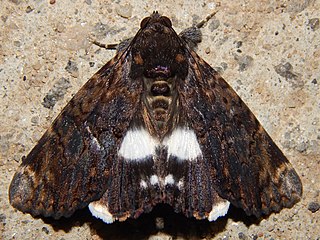The Human Resources, Science and Technology Committee of the African Union was created to deal with the issues surrounding the development of Education, Illiteracy, Information technology, Communication, Human resources and Technology in Africa.
Caecilia subterminalis is a species of caecilian in the family Caeciliidae. It is endemic to Ecuador.

Catephia is a genus of moths of the family Erebidae. Most species of this genus are found in Africa.

Nagia is a genus of moths of the family Erebidae. The genus was erected by Francis Walker in 1858.

Schoenoplectus subterminalis is a species of flowering plant in the sedge family known by the common names water bulrush, water club-rush, and swaying bulrush. It is native to North America, where it is known from many parts of the Canada and the United States. It has been common in the northeastern US and eastern Canada as well as the Great Lakes region, as well as many locations in the mountains of the West, though apparently absent from the Southwest and from most of the Great Plains.
The Catephiini are a tribe of moths in the family Erebidae.

Nagia linteola is a species of moth in the family Erebidae first described by Achille Guenée in 1852. This species occurs in South Africa, the Democratic Republic of the Congo, Yemen, the Comoros, Mauritius, Madagascar, Indonesia (Borneo), India, Sri Lanka, Myanmar, Thailand and in Australia, where it has been recorded from Western Australia, the Northern Territory, Queensland and Victoria.

Nagia promota is a species of moth in the family Erebidae, this species occurs in Madagascar.
Palestinian Haitians are Haitians of Palestinian descent, or Palestinians with Haitian citizenship.
Nagia amplificans is a species of moth in the family Erebidae. It is found in South Africa, where it has been recorded from KwaZulu-Natal.
Nagia evanescens is a species of moth in the family Erebidae. It is found in Nigeria.
Nagia gravipes is a species of moth in the family Erebidae. It is found in Sierra Leone and South Africa.
Nagia homotona is a species of moth in the family Erebidae. It is found in Ghana.
Nagia melipotica is a species of moth in the family Erebidae. It is found in South Africa.
Nagia microsema is a species of moth in the family Erebidae. It is found in Ghana, Kenya and Nigeria.
Nagia monosema is a species of moth in the family Erebidae. It is found in Ghana.
Nagia pseudonatalensis is a species of moth in the family Erebidae. It is found in Tanzania.
Nagia sacerdotis is a species of moth in the family Erebidae. It is found in Malawi and South Africa.
Nagia subalbida is a species of moth in the family Erebidae. It is found in South Africa.
Eugenia subterminalis, commonly known as cambuí pitanga, cereja do mato verdadeira, pitanga lisa de sombra, pitanga preta, and cambuízão vermelho do rio Paranapanema, is a species of plant in the family Myrtaceae. It is endemic to araucária forest in Bolivia, northern Brazil, Colombia, Ecuador, and Peru. The plant is a semi-deciduous shrub that grows to between 2 and 4 metres tall, and produces egg shaped fruit between 15 and 25mm tall, and 18 to 20mm wide.



